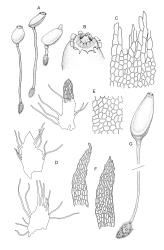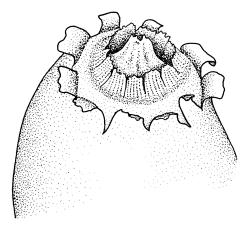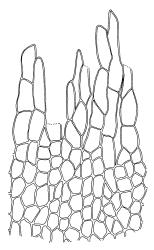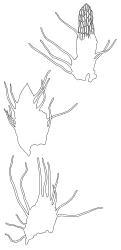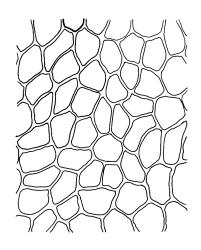Plants mostly gregarious, arising from persistent and pale protonemata. Leaves sparse (occasionally not observable) at base of setae, lingulate or highly irregular in outline and irregularly toothed or long ciliate. Mid laminal cells mostly oblong-hexagonal, c. 30–39 × 15 µm.
Setae red, 1.5–18 mm, coarsely or rarely finely papillose (prorate) throughout, swollen at base and usually with a felt of protonemata and persistent leaves; capsules 3–5 mm, inclined to horizontal, red- or yellow-brown at maturity, broadly obovate in outline, plane or nearly so on upper surface, convex on lower surface, the surfaces separated by a distinct, raised, and often dark red border, tapering to a narrow, ± transverse mouth which at maturity is surrounded by irregular and reflexed flaps of exfoliating exothecial cells, with a small and weakly swollen neck; exothecial cells ± hexagonal, firm-walled, mostly 40–50 µm; stomata deeply immersed, 1- or 2-celled; operculum c. 0.8 mm high, conic, rounded at apex. Exostome teeth variable in number, dark brown, each tooth irregular to triangular, composed of 2–3 layers of parallel bundles of intact cells, smooth or nearly so. Calyptra c. 1 mm. Spores c. 5–7(–12) µm, smooth.
NI: N Auckland (Waitakere Ranges), S Auckland (Pārāwera, Rotorua-Taupō-Kaingaroa area); SI: Nelson (Abel Tasman N.P.), Canterbury (Lewis Pass, Arthur’s Pass, Hawdon River), Westland (Pegleg Creek), Otago (Waitātī, Flagstaff Hill, Berwick, Paradise).
Bipolar. Tasmania*, mainland Australia (Qld)*, widespread but local in northern hemisphere.
On soil on alluvial terraces, rock, logs or stumps, usually in relatively open vegetation such as scrub or low mānuka forest, occasionally in subalpine grasslands and also in plantations of pine and larch (Larix decidua). The base, lower trunks and rotten stumps of larch provided the habitat for a number of collections from the Kaingaroa Plains in S Auckland L.D. Once collected from damp sandstone. Frequently associated bryophytes include Campylopus introflexus, Ceratodon purpureus, Dicranoweisia antarctica, Notoligotrichum australe, Leptotheca gaudichaudii, and Lepidozia spp., while associated lichens include the genera Cladia, Cladonia, Peltigera, and Psoroma. On NI from 100–550 m; on SI from near sea level to c. 1100 m.
Fruiting Buxbaumia aphylla has been collected from NI in all seasons, while from SI it has been collected mainly in late winter to spring. Crum & Anderson (1981, p. 1236) indicated that in eastern North America the "capsules mature over the winter" and shed spores in the spring. Hancock & Brassard (1974) suggest that in Newfoundland, Canada, the gametophytes may persist for two to several years and give rise to annual crops of sporophytes.




